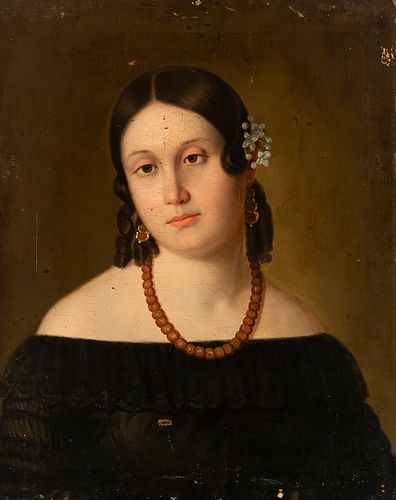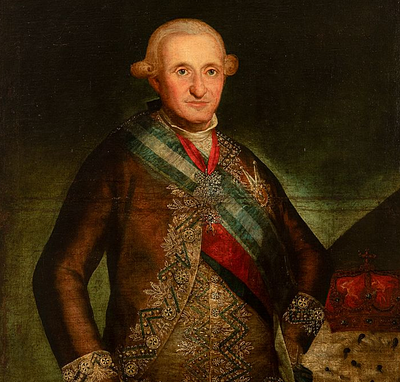Circle of ANTONIO MARÍA ESQUIVEL Y SUÁREZ DE URBINA (Seville, 1806 - Madrid, 1857). "Portrait of a Lady. Oil on canvas. Relined
Lot 50
About Seller
Setdart Auction House
Carrer Aragó 346
Barcelona
Spain
Setdart Subastas was born in 2004 and is currently the first online art auction in Spain with solidity, prestige and reliability guaranteed by our more than 60,000 users. Setdart has a young, dynamic and enterprising team ready to successfully manage the purchase and sale of art works through custom...Read more
Estimate:
EUR€600 - EUR€800
$618.56 - $824.74
Absentee vs Live bid
Two ways to bid:
- Leave a max absentee bid and the platform will bid on your behalf up to your maximum bid during the live auction.
- Bid live during the auction and your bids will be submitted real-time to the auctioneer.
Bid Increments
| Price | Bid Increment |
|---|---|
| EUR€0 | EUR€10 |
| EUR€200 | EUR€25 |
| EUR€500 | EUR€50 |
| EUR€1,000 | EUR€100 |
| EUR€3,000 | EUR€200 |
| EUR€5,000 | EUR€500 |
| EUR€10,000 | EUR€1,000 |
| EUR€20,000 | EUR€2,000 |
| EUR€50,000 | EUR€5,000 |
About Auction
By Setdart Auction House
Sep 22, 2021
Set Reminder
2021-09-22 09:30:00
2021-09-22 09:30:00
America/New_York
Bidsquare
Bidsquare : 22nd September - ARAS JÁUREGUI Private Collection - Old Masters, 19th & 20th Century
https://www.bidsquare.com/auctions/setdart-auction-house/22nd-september---aras-j-uregui-private-collection---old-masters-19th-20th-century-7427
ARAS JÁUREGUI Private Collection - Old Masters, 19th & 20th Century Setdart Auction House sofia@setdart.com
ARAS JÁUREGUI Private Collection - Old Masters, 19th & 20th Century Setdart Auction House sofia@setdart.com
- Lot Description
Circle of ANTONIO MARÍA ESQUIVEL Y SUÁREZ DE URBINA (Seville, 1806 - Madrid, 1857). "Portrait of a Lady. Oil on canvas. Relined It presents repainting and faults. Measurements: 52 x 42 cm. This work follows the aesthetic precepts of the portrait, imposed by Antonio María Esquivel, who was characterized by the mastery in the romantic capture of the personality. These features of Romanticism can also be seen in this particular work, as can be seen in the lady's clothing and hairstyle, and even in the use of a sober palette of dark tones, applied with a precise, tight technique. Esquivel was the most representative and prolific painter of Sevillian Romanticism and one of the most outstanding of his time in Spain. Trained at the Seville Academy of Fine Arts, he was appointed chamber painter in 1843 and a member of the San Fernando Royal Academy in 1847. He contributed to the publications "El siglo XIX" and "El Panorama" and was a member of the Artistic and Literary Lyceum. He taught at the San Fernando Academy in Madrid. Although he dealt with a wide range of subjects, portraiture is an essential part of his career. In addition to his artistic merit, his portraits illustrate the society of his time with historical rigour, without neglecting affective values. He received many commissions for portraits in various formats, and also produced several self-portraits, one of which is in the Museo del Prado. He also executed group portraits, which reflect his fascination with the Dutch Baroque and his corporate portraits. With regard to religious themes, he was a follower of Murillo, in connection with his own status as a Sevillian. His history paintings had a very personal, literary and theatrical character, the result of the Romantic atmosphere in which he lived. His official awards include the plaque of the Siege of Cadiz and the Cross of Commander of the Order of Isabella the Catholic. In 2006, in commemoration of his second centenary, the Seville Academy of Fine Arts, in collaboration with the El Monte Foundation, held a retrospective exhibition dedicated to his work. He is represented in numerous private collections and institutions such as the Prado Museum, the Huesca Town Hall, the Lázaro Galdiano Museum in Madrid, the Fine Arts Museum in Seville, the Romantic and Naval Museums in Madrid, the National Library and the Santa Cruz Museum in Toledo, among many others.
- Shipping Info
-
In-house shipping available. Please inquire at admin@setdart.com.
-
- Buyer's Premium



 EUR
EUR CAD
CAD AUD
AUD GBP
GBP MXN
MXN HKD
HKD CNY
CNY MYR
MYR SEK
SEK SGD
SGD CHF
CHF THB
THB















